Active Transport Can Only Be Driven by the Hydrolysis of High-energy Phosphate Bonds.
eleven.5: Agile Transport
- Folio ID
- 51045
Figure \(\PageIndex{x}\) below shows an interactive iCn3D model of xxx (xxxx).
paradigm
Figure \(\PageIndex{x}\): xxx (xxxx). (Copyright; author via source). Click the image for a popup or use this external link:
In the previous sections, nosotros explored facilitated diffusion, improvidence through channels, and diffusion through larger pores. In each case, once a carrier/permease protein was available, or a aqueduct (gated by ligand bounden, alter in membrane potential, lipid binding or mechanical forces) or a pore formed, solute flows down a chemical gradient (facilitated diffusion) or electrochemical gradient in a thermodynamically favored procedure. But what well-nigh moving solutes from low to loftier concentration, against a concentration gradient, which would exist necessary to capture the last bit of a vital food or free energy sources? Active transport does just that, but it requires an energy source to do so. Many different types of chemical species are actively transported beyond the jail cell and organelle membranes, including sugars, amino acids, (deoxy)nucleotides, metabolites (like carboxylic acids),
Blazon of Active Transport
For active ship to occur, a membrane receptor is required which recognizes the ligand to be transported. Of major interest to u.s., however, is the free energy source used to drive the transport against a concentration gradient. The biological world has adapted to employ most whatsoever source of free energy available.
ATP hydrolysis: One would expect that this ubiquitous carrier of free energy would by used to drive active transport. In fact, this is one of the predominant roles of ATP in the biological earth. 70% of all ATP turnover in the encephalon is used for the creation and maintenance of a Na and 1000 ion gradient across nerve cell membranes using the membrane protein Na+/K+ ATPase.
Energy released past oxidation: Y'all may have encountered this in previous biology course. Active send of protons driven by oxidative processes where are exergonic. In electron send in respiring mitochondria, NADH is oxidized as it passes electrons to a series of mobile electron carriers (ubiquinone, cytochrome C, and eventually dioxygen) using protein complexes in the inner membrane of the mitochondria. The energy lost in this thermodynamically favored process is coupled to conformational changes in the complex which caused protons to be ejected from the matrix into the inner membrane infinite. One can imagine a series of conformation-sensitive pKa changes in various side chains in the complexes which lead in concert to the vectorially belch of protons.
Lite: Photosynthetic bacteria have a membrane protein chosen bacteriorhodopsin which contains retinal, a conjugated polyene derived from beta-carotene. It is analogous to the visual pigment protein rhodopsin in retinal cells. Absorption of low-cal by the retinal induces a conformation changes in the retinal and protein, which leads to vectorial discharge of protons ;
Collapse of an ion gradient: The favorable plummet of an ion slope can be used to bulldoze the transport of a unlike species confronting a concentration gradient. Nosotros have already observed that collapse of a proton gradient beyond the inner mitochondria membrane (through F0F1ATPase) can drive the thermodynamically unfavored synthesis of ATP. Plummet of a proton gradient provides a proton-motive force which can drive the active ship of sugars. Also a sodium-motive force tin can drive active send of metallic ions. Since the energy to make the initial ion gradients unremarkably comes from ATP hydrolysis, ATP indirectly powers the transport of the other species against a gradient.
Active transport can be divided into two classes:
- chief - driven by "chief" free energy sources, which for us ways ATP or photons
- secondary - driven past coupled transport (also called cotransport) of solutes down a concentration gradient, which provides the thermodynamic force to motion a solute "uphill".
Active transporters tin also be divided in classes based on the direction of movement of the solute and any cotransported solute into uniport (no cotransported solute), symport (solute and cosolute transported in the aforementioned direction) and antiport (solute and cosolute transported in the reverse management) equally shown in Figure \(\PageIndex{i}\) beneath.
Figure \(\PageIndex{1}\): Uniport (no cotransported solute), symport (solute and cosolute transported in the aforementioned direction) and antiport (solute and cosolute transported in the opposite management) transporters
Examples of these different mechanisms can be found in facilitated diffusion likewise equally active send. Example of these types include:
- uniport: An oftentimes used example is GLUT 1, which catalyzes the FACILITATED Improvidence (not active transport) of glucose down a concentration gradient. A somewhat complicated instance of a uniport active transporter is the Na+/M+ATPase, which moves Na+ ions out of a cell and Thousand+ into a cell, both against concentration gradients. The movement of ane ion does not provide the chemical potential thermodynamic driving forcefulness to move the other. Rather the hydrolysis of ATP is required. And then this protein tin can exist chosen a uniport agile transporter for ii different ions.
- symport: A another glucose transporter, the glucose symporter (SGLT1), found in the small intestines, heart and the brain, cotransports one glucose or galactose for every ii Na+ ions that move into the cells down a concentration gradient.
- antiport: The sodium-calcium exchanger pumps out one Ca2+ ion (depression to high concentration) driven by the influx of iii Na+ into the prison cell. This keeps Ca2+ low in the cytoplasm.
If the species moved is charged, two other terms are used:
- electrogenic - a net electrical imbalance is generated across the membrane by symport or antiport of charged species
- electroneutral - no cyberspace electrical imbalance is generated across the membrane past symport or antiport of charged species
In this affiliate section we volition explore examples of several types of active transporters. All are polytopic with alpha-helical transmembrane domains, which through a series of conformational transitions can motility chemic species that are jump the receptor or aqueduct protein to move through the membrane through the cosmos of transient openings in the protein. We volition cease with another look at the nuclear pore circuitous and come across how it allows motility of large proteins and RNA molecules through its pore through a very different type of mechanism. In that case, information technology is non really active send since relative concentration of the transported species on either side of the pore are less important than machinery by which sure species are targeted to motility into and out of the nucleus.
Major Facilitator Superfamily (MFS) Transporters
These are about 74 unlike families of active transporter in the Major Facilitator Superfamily (MFS), which is the largest of secondary transporters using symport or antiport mechanisms. At that place are also uniporters within this family. Different members of the MFS move a diverse array of solutes, including sugars, nucleotides, peptides and drugs across membranes against a concentration gradient. All take two membrane domains consisting of six transmembrane helix bundles that pack to give an apparent two fold rotational axis of symmetry (also called pseudo C2 axis). The ligand to be transported binds between the ii domains in a central cavity potentially open up to either side of the membrane. Effigy \(\PageIndex{2}\) console A (elevation) below shows a cartoon of the 12 helices and half dozen-helix bundles. Helix ane and four in domain i and the analogous ones in domain two, 7 and 10, involved in ligand movement through the membrane. Correspondingly, helices ii, 5, viii and 11 are involved in domain-domain interactions. The bottom figure (B) shows two views of the poly peptide with the ligand in spacefill rendering.

Figure \(\PageIndex{2}\): Construction of the Major Facilitator Superfamily (MFS). images from Lee J, Sands ZA and Biggin PC (2016) A Numbering System for MFS Transporter Proteins.Front. Mol. Biosci. 3:21. doi: 10.3389/fmolb.2016.00021Creative Commons Attribution License (CC Past)
As construction mediates function, they all display a similar "clamp and switch" mechanism, in which solute binds to the poly peptide in an open up (to binding) conformation, leading to conformation changes forming a closed form, followed by further conformational changes which causes the complex to open up to the other side of the membrane. Figure \(\PageIndex{3}\) beneath shows hands opening, endmost and reopening in the other direction equally an illustration for this "clamp-switch" mechanism.
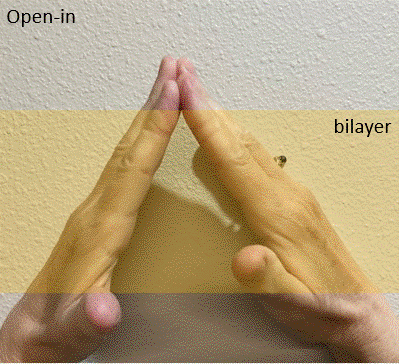
Figure \(\PageIndex{3}\): Hands opening, closing and reopening in the other direction as an analogy for this "clamp-switch" mechanism of the Major Facilitator Superfamily (MFS)
We will describe two dissimilar transporters in this family.
Human monocarboxylate transporter (7BP3)
This proton-linked monocarboxylate transporters (MCTs) moves many moncarboxylates (including lactate, pyruvate, and the ketone bodies acetoacetate, beta-hydroxybutyrate and acetate) out of the jail cell, driven by menstruation of protons beyond the membrane in the aforementioned directions (symport). In cells engaging in glycolysis, a fundamental energy utilization pathway, information technology catalyzes the high-analogousness transport of pyruvate, the terminate product of glycolysis, and lactate, a reduced derivative of pyruvate, out of the cell. In cells that are not engaged in glycolysis, its activeness is effectively turned-off. The flux of pyruvate/lactate has steep dependence on their concentrations, allowing the poly peptide to act as on on-off switch for transport. A stride dependency of activity on concentration is a authentication of cooperative interactions. Structural analyzes show conformational changes in the interface of the dimeric grade of the transporter.
We will see when we written report glycolysis, the conversion of the oxidized pyruvate to its reduced form lactate, requires a reducing agent, in this case NADH, which is oxidized dorsum to NAD+, an oxidizing agent required for glycolysis to continue. When pyruvate is loftier, NADH is likewise loftier, allowing for conversion of pyruvate to lactate, which can be exported out of the cell. The interconversion is described by this reaction:
Pyruvate + NADH ↔ Lactate + NAD+
Using MCT two to remove lactate from the cell pulls the above reaction to the correct, regenerating NAD+, allowing glycolysis to continue.
Effigy \(\PageIndex{4}\) below shows an interactive iCn3D model of the inward open human being monocarboxylate transporter 2 (7BP3) .
.png?revision=1&size=bestfit&width=430&height=303)
Figure \(\PageIndex{4\): In open human being monocarboxylate transporter ii (7BP3). (Copyright; writer via source). Click the paradigm for a popup or utilise this external link: https://structure.ncbi.nlm.nih.gov/i...yq5U8v4BvdDA57
Several key residual are shown. Aspartic acrid 293 (side chains in red sticks) is conserved in all MCTs studied and is likely involved in H+ transport. It is surrounded past Val 156, Met 289, Ala 290 and Phe 351 (side chains in cyan sticks), all nonpolar amino acid which would elevate the pKa of Asp 293, allowing information technology to stay protonated until a conformational change would alter its environment, leading to proton release. Ii positive charged residues, Lys 38 and Arg 297 (side chains in blue sticks) are involved in substrate interactions. Lys 38 faces to the outside of the cell in the inwards open conformation. Figure \(\PageIndex{5\) below shows the same amino acids in a zoomed view. The amino acids are labeled.
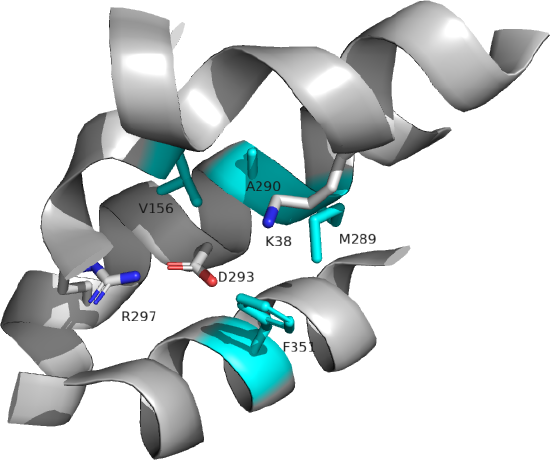
Figure \(\PageIndex{5\): Cardinal amino acid side chains in inward open up man monocarboxylate transporter 2 (7BP3)
Lactose Permease (Lactose-proton symport)
This Due east. Coli protein is also a symporter, which uses the move of H+ downwardly a concentration slope to drive lactose into East. Coli to capture equally much lactose - an energy source - as possible. Deprotonation of a protonated Glu 269 leads to ligand binding equally the protein has no binding site in the protonated site. Lactose induces the formation of its binding site. Effigy \(\PageIndex{6\) below shows the alter in conformation going from a more acidic pH (five.6, PDB 2CFP) to a more than neutral pH (6.5, PDB 2CFQ). 1 lactose is transported from one H+, which moves downward a concentration gradient. Lactose moves from the outside periplasm to the cytoplasm.
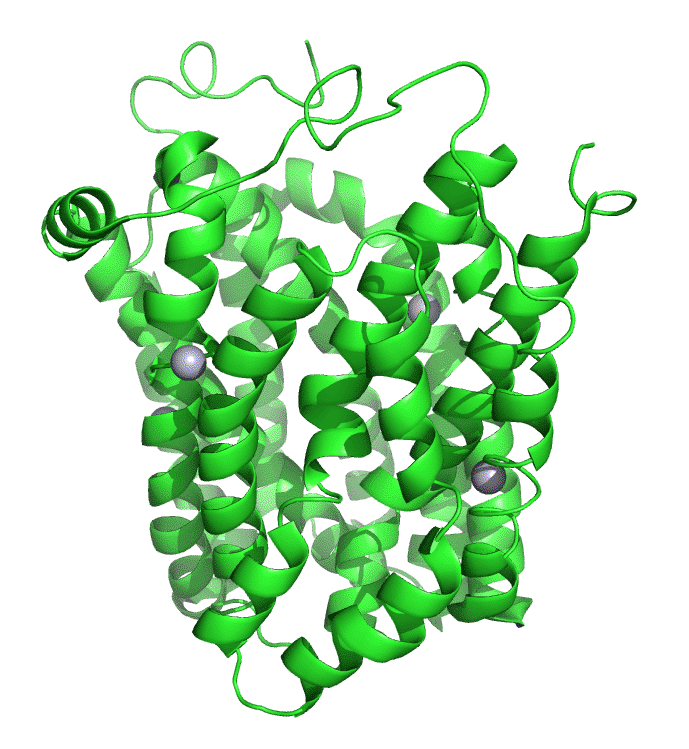
Figure \(\PageIndex{half dozen\): Conformation changes in lactose permease from a more than acidic pH (5.half-dozen, PDB 2CFP) to a more neutral pH (6.5, PDB 2CFQ)
Hither is an iCn3D models showing lac permease (1pv7), which highlights three residues essential for lactose binding (Glu 126, Arg 144 and Glu 269 in stick) and three involved in proton transfer (Arg 302, His 322 and Glu 325 in spacefill). It has a jump nonhydrolyzable lactose analog (beta-D-galactopyranose-(i-one)-1-thio-beta-D-galactopyranose), shown in spacefill, in the center hydrophilic cavity. The ii 6-helix bundles, which give pseudo 2-fold symmetry are clearly evident. The protein is in the open-to-in conformation. (The blue dummy atoms represent the inner leaflet.)
Figure \(\PageIndex{7}\) beneath shows an interactive iCn3D model of lac permease (1pv7), which highlights three residues essential for lactose binding (Glu 126, Arg 144 and Glu 269 in stick) and three involved in proton transfer (Arg 302, His 322 and Glu 325 in spacefill).
.png?revision=1&size=bestfit&width=412&height=347)
Figure \(\PageIndex{7}\): Lac permease (1pv7). (Copyright; author via source). Click the image for a popup or utilize this external link: https://structure.ncbi.nlm.nih.gov/i...9mt2juToECQPg6
Figure \(\PageIndex{viii}\) is a video of a molecular dynamics simulation showing lactose moving through lactose permease.
Figure \(\PageIndex{eight}\): Molecular dynamics simulation showing lactose moving through lactose permease. https://www.ks.uiuc.edu/Gallery/Movi...annelProteins/
As with other members of the MFS transporters, lactose permase has 12 transmembrane helices that form two bundles. The lactose bounden site is betwixt the two bundles. When the protein is in the open-to out conformation, it can bind bind protons, most likely at an exposed His. This enables lactose binding, which is followed past a conformational change to the open up-to-in form. The protonated His loses a proton and lactose dissociates into the cytoplasm. Move of both H+ and lactose together must occur for transport.
Structural piece of work past Singh et al on the Leu Transporter (LeuT), a member of the solute carrier half dozen or sodium coupled transporters, which is an active transporter requiring motion of Na ion into the cells to ability the uptake of Leu, show an "open-to-out" and occluded binding state for ligand (Leu). Tryptophan, a competitive nontransportable inhibitors binds to the open-to-out state, only is too large for the obligate occluded state so information technology is not transported. Effigy \(\PageIndex{9}\) shows inward open up, airtight, and outward conformations of different major facilitator superfamily transporters.
Figure \(\PageIndex{9}\): Inward open, closed, and outward conformations of different major facilitator superfamily transporters
Another fellow member of the MFS Transporter family unit in LeuT, the leucine transport, which is similar to the neurotransmitter sodium symporter. Effigy \(\PageIndex{x}\) below shows the transition between two conformational states. The first is the outward open leucine transporter (LeuT). This initial state has bound tryptophan, a competitive inhibitor, which is to big to ship, which traps the bound state in the open conformation. The second state has bound Leu and is closed. The conformational changes are subtle but sufficient to allow transient bounden, occlusion, the expulsion to the other side of the membrane (not shown). Note likewise the ii bound Na+ ions (majestic) clearly showing that active transport through this transporter is driven by Na+ ions. The ions are farther apart in the open country assuasive access of the amino acid for ship.
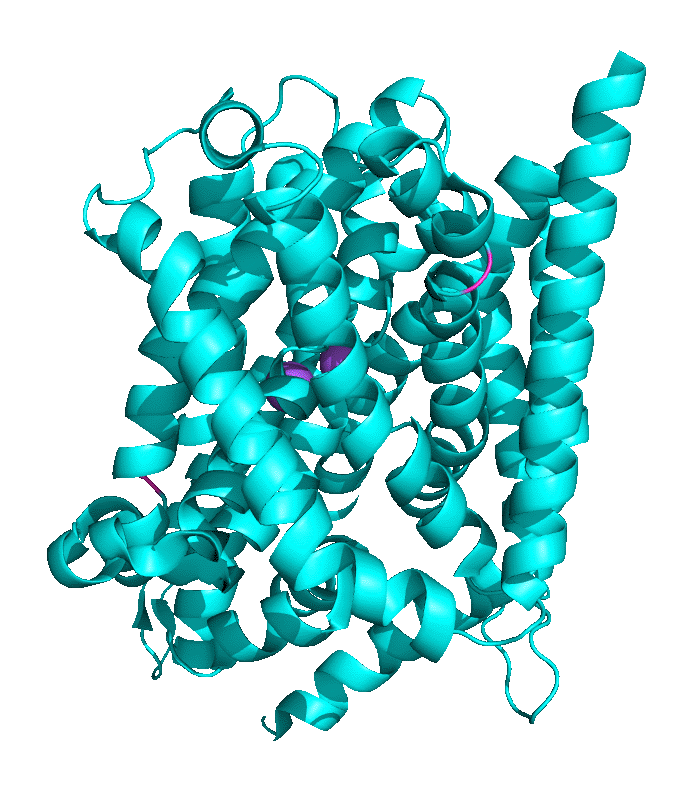
Effigy \(\PageIndex{x}\): Transition betwixt two conformational states of the Leu transporter
Membrane ATPases
https://opm.phar.umich.edu/protein_superfamilies/22
Many active transporters power uphill send of solute through coupled exergonic cleaveage of ATP. The largest family unit of these are the P-type ATPase, which are used to transport a host of different solutes, including ions (Cu, Zn, Mn, Mg, Ca, Na, K, Cd, Co, Pb, Ni and H) and phospholipids (from one leaflet to some other by translocases like flippases). They really convert chemical free energy (from cleavage of phosphoanhydride bonds) to electrochemical potential free energy. Over 160,000 P-blazon ATPase from both prokaroytes and eukaryotes are known so they are highly prevalent and evolved early in time. They should exist understood at both a structural and themodynamic level.
How is energetic coupling achieved? An early model proposed past Albers and Post suggested that energetic coupling occurred past covalent transfer of a terminal phosphate (Pi) from ATP to an Asp in the poly peptide channel to form a covalent Asp-Pi intermediate, which is an example of a mixed anhydride. This is illustrated in Figure \(\PageIndex{11}\) below.
Effigy \(\PageIndex{11}\): Formation of high free energy (with respect to its hydrolysis products) mixed anhydride of Asp in membrane ATPase
This reaction is actually disfavored thermodynamically since hydrolysis of ATP to form ADP proceeds with a less negative ΔG0 than the aforementioned reaction with a mixed anhydride. However, ultimately hydrolysis of the mixed anhydride in the next step would make the overall coupled reactions favorable.
Another feature of the Mail-Albers model is that the phosphorylated channel, P-ATPase, has two conformations:
- a loftier affinity cation inward (cytoplasm) facing cation binding site called Eastwardone
- a depression affinity cation outward (extracellular or luminal) facing cation binding site called Eastii
Figure \(\PageIndex{12}\) belows a more detailed (A) and simpler (B) set up of chemic equations to represent the dissimilar state of E1 and Due east2 in the Post-Albers model.
The adjacent three figures are from the following reference: Zhang, X.C., Zhang, H. P-type ATPases use a domain-clan mechanism to couple ATP hydrolysis to conformational change.Biophys Repv,167–175 (2019). https://doi.org/10.1007/s41048-019-0087-one. Artistic Commons Attribution 4.0 International License (http://creativecommons.org/licenses/by/four.0/
Figure \(\PageIndex{12}\): Chemical equations for conversion of states E1 and Eastward2 for membrane ATPases in the Post-Albers mode
- The top line in both shows the reactions of Eane (high analogousness) with substrate (ions) and ATP. Since Due easti is phosphorylated by ATP, it is considered a kinase.
- The bottom line in both shows the reactions of Eii (low affinity) with substrate (ions). Since Due easttwo is dephosphorylated, it is considered a phosphatase.
S1 and Sii differ for specific P-blazon ATPase.
Detailed Structures
Now let'south looks at the structures of a specific P-type ATPase, the sarcoplasmic/endoplasmic reticulum calcium ATPase 1 (or more than merely a Ca2+ pump), which catalyzes the active uphill transport of Ca2+ from the cytoplasm back into the lumen of the sarcoplasmic reticulum (SR) in muscle cells and acts in the regulation of striated muscle contraction. The actual gratis concentration of Ca2+ in the SR is well-nigh 390 μM compared to 0.1-0.two μM in the cytoplasm. On muscle excitation Catwo+ flood out into the cytoplasm, just must be actively transported back into the SR by the Caii+ pump.
Here is the simplified chemical reaction: ATP + Ca two+ (cyto) + H 2 O → ADP + Ca 2+ (south. rect) + H + + Pi.
We'll stick with a cartoon representation of each of the diverse structure states of this calcium pump, as illustrated in Effigy \(\PageIndex{thirteen}\) below (as well from Zhang et al).
Figure \(\PageIndex{13}\): States of this calcium pump
Again, different states of E1, the kinase land, are shown in the top line, while E2, the phosphatase state, are shown in the bottom line. PDB IDs are shown for each country. Ca2+ is shown as a cyan sphere. Annotation how the cytoplasmic N (nucleotide-bounden), P (phosphorylation) and A (actuator) domains and the single transmembrane domain, colored to show the C-terminal (CTM) and Due north-terminal (NTM). are represented in the cartoon version to the right. P represents the phosphorylated Asp 351 mixed anhydride. The asterix * denotes a transition state toward phosphorylation of Asp 351 (height line) and its dephosphorylation (lesser line).
Ca2+ moves from the cytoplasm to the lumen of the SR. Note the the kickoff E1 land is open up in (to the cytoplasm) while the first East2 state is open up outward (to the lumen of the Sr, where the bulk of the Caii+ ions are stored. This mimics the open-in and open up-out states of the Major Facilitator Superfamily (MFS) channels discussed above.
Detailed Thermodynamics
Zhang et al provide ii different views of the thermodynamics of Ca2+ ion pumping into the SR as shown in A (domain dissociation) and B (classic) in Figure \(\PageIndex{14}\) below. A quick view of the two "energy landscapes" prove:
- Both get from college to lower costless energy as expected since ATP hydrolysis powers the process.
- They differ mostly in the energetic coupling steps
Effigy \(\PageIndex{14}\): Thermodynamics of Ca2+ ion pumping into the SR as shown in A (domain dissociation) and B (archetype)
In A, the actual energy released in ATP hydrolysis occurs when the Asp 351-Pi mixed anhydride is dephosphorylated (ΔGdeph) is coupled to the dissociation of the P and A ( * actuator) domains. This shown in the structural cartoon nigh the last step in the complete cycle.
In the cartoon diagram, 6 states are represented. Whatever mechanism can be broken down into more and more states on a more complete clarification of the actual machinery . For instance, ATP cleavage to ATP can exist represented by 3 states, ATP, ADP and Pi, or many more if intermediates and transition states are include, the consummate Caii+ transport bicycle in the thermodynamics diagram is broken down into 12 states, represented by 8 horizontal solid lines _____and 4 dashed ------ lines. Vertical lines with arrows show transitions between stated.
- Greenish arrows →shows changes in free energy due to relative stability (chemical potential) of ATP.
- Red arrows → shows changes in costless energy due to relative stability (chemical potential) of the substrate ions
- Cyan arrows → show changes in costless energy due to electric potential of the substrate ions
ΔGL are for steps involving loading of reactants, while ΔGR are for release. In both diagrams the conversion of state Eastone .Southward.ATP to EastaneP.S is uphill as we predicted for the germination of the
On the far right of each graph are identical sets of big unfilled arrows (since ΔG is a state function) every bit the beginning and ending gratuitous energies of free Ei must be path (i.e. mechanism) independent. The two sets of upwardly unfilled arrows ( red for change in chemical potential of the substrate ions and cyan for the change in electric potential of the substrates are both positive every bit the ions move uphill from a lower to high electrochemical potential. The unfilled downward green arrow shows the change in free energy (or chemical potential) for ATP hydrolysis. Since free energy cannot exist created or destroyed, the narrow black arrow (Q10) represenets free energy that is prodigal in the reaction bike. The starting and ending states are identical (i.e., Eastward1), merely existence differed past the energy dissipation (denoted asQ 10 ) of the P-ATPase transporter during one functional cycle.
The are other types of membrane ATPase whose structure and function differ from the P-type described above. Some run in contrary to actually synthesize ATP. They also vary in substrate ions. Hither are several unlike types.
- F-ATPases (ATP synthases, FaneF0-ATPases): These are used to synthesize ATP and are powered by the collapse of a H+ slope. They are found n mitochondria, chloroplasts and bacterial cell membranes. Nosotros will talk over these more in chapters on mitochondrial oxidative-phosphorylation and photosynthesis is chloroplast.
- V-ATPases (5one50-ATPases): These are used to pump protons into organelles to acidify them (ex. lysosome) and are also constitute in bacteria.
- A-ATPases (A1A0-ATPases): These are used to synthesize ATP in Archaea .
- East-ATPases: These are institute on the prison cell surface and hydrolyze extracellular nucleotide triphosphate.
Allow's now look at some special feature of one P-type ATPase that transports both Na+ and G+ ion and is important in establishing their intracelluar and extracellular concentration in neurons, so they are critical for neuron office.
Na+/K+ ATPase
This protein keeps the K+ in and Na+ out high compared to their respective concentrations on the other side of the neural prison cell membranes. ATP and 3 Na+ ions bind to the cytoplasmic domain of the enzyme in the E1 conformation. Every bit described more than generally above, in the presence of Na ions, the bound ATP is broken in a nucleophilic atack by an Asp side concatenation of the protein. Hence, the protein is a Na+-activated ATPase or kinase. The phosphorylated enzyme changes conformation to the Due east2 form in which Na+ ions are now on the outside of the cell membrane, from which they dissociate. The phosphorylated protein in conformation Eastward2 now binds 2 K + ions on the exterior, which activates hydrolysis of the Asp-POiii mixed anhydride link. The dephosphorylated protein is more than stable in the E1 conformation to which information technology changes equally it bring Thou+ ions into the cell. Hence this protein is an electrogenic antiporter. P-Blazon transporters are inhibited by vanadate (VO4 three-), a transition country analog of phosphate. Ship mediated by P type membrane proteins tin can, in the lab, be used to drive ATP synthesis.
Detailed kinetic analysis of ATP and VO4 three- interactions testify there are a low affinity and high affinity site for each on Na/K ATPase. The high affinity vanadate site appears to be the same as the low analogousness ATP site, which advise that vanadate binds tightly to the E2 form of the enzyme. The low analogousness vanadate site appears to be the same site (based on competition assays) as the ATP site, which is probably the Eone form. Hence vanadate binds preferentially to the E2 form which would inhibit the transition to the Due east1 form. Vanadate also inhibits phosphatases, enzymes that cleaves phosphorylated Ser, Thr, and Tyr - phosphoesters in proteins. This supports the notion that vanadate binds preferentially to the E2 form, which has a phosphoanhydride link (Asp-O-phosphate) that is hydrolyzed, promoting the conversion of E2 dorsum to Ei. Vanadate is probably a transition state analog inhibitor in that it can readily adopt a trigonal bipyramidal structure, mimicking the transition land for cleavage of the tetrahedral anhydride bonds of ATP and Asp-O-PO3.
Figure \(\PageIndex{15}\) is a YouTube animation of the Na+/Thousand+ ATPase from xx. Permission Question?
Figure \(\PageIndex{xv}\): Blitheness of the Na+/K+ ATPase pump
These interactions are depicted in Figure \(\PageIndex{sixteen}\)below (subsequently Stryer 4th ed)
Figure \(\PageIndex{16}\): Steps of the Na+/K+ ATPase pump
ATP-binding cassette (ABC) transporters
The proteins incorporate one of the largest families of membrane proteins with seven main families (ABCA to ABCG). Upward to 3% of all bacterial proteins encode proteins associated with the ABC transporters. Dissimilar ABC transporters move a variety of required chemical species, from modest (ions, sugars, amino acids, nucleoside, vitamins) to big (peptides, lipid , oligonucleotides and polysaccharides) into the cell. They too remove toxic (to the cell) molecules such as xenobiotics (molecules foreign to the cell like drugs, toxins, etc) and potentially toxic metabolites. All of these requires ATP hydrolysis. Moving toxic molecules out of the jail cell is plainly beneficial to the health of the cell, but in the example of a tumor cell, non to the benefit of the organism. TAs in other agile transporters using ATP, its hydrolysis leads to two unlike conformations, open outward open inward. All ABC transporter have a LSGGQ amino acrid sequence in the NBD. They also take a phosphate-binding loop (P-loop or Walker A motif). Most eukaryotic ABC transporters movement solutes from the inside to the outside of the cell.
The diverse structures inside the ABC transporter superfamily are shown in Effigy \(\PageIndex{17}\) below. The transmembrane domain (TMD, in light-green) and the nucleotide bounden domain (NBD, blueish) are present in most versions of the cistron. PK represents prokaryotic and EK eukaryotic organisms (shown at the very right for each).
Figure \(\PageIndex{17}\): Variations in the structures within the ABC transporter superfamily ng, J., Feng, J., Yuan, D.et al. Tracing the structural evolution of eukaryotic ATP binding cassette transporter superfamily.Sci Repv,16724 (2015). https://doi.org/10.1038/srep16724. Creative Commons Attribution 4.0 International License.http://creativecommons.org/licenses/by/4.0/
The ABC transporter genes denoted as total structures accept 2 TMDs and 2 NMDs while one-half structures have i of each. Some of the genes encode either a single NBD or a single TMD (prevalent in prokaryotes, forth with half structures). The ABC2 structure has simply ii NBDs. Single structure represents the ABC transporter gene with a single TMD or NBD; ABC2 structure represents the ABC transporter cistron with just two NBDs. The families possessing certain structures are listed on the right. TMD typically accept 6-ten transmembrane α-helices. Those that are involved in consign of chemical species accept six.
Structural cartoon representing domain and ligand binding for a multifariousness of ABC transporters are shown in Effigy \(\PageIndex{18}\):beneath.
Figure \(\PageIndex{18}\): Domain and ligand binding for a multifariousness of ABC transportersStructure and mechanism of ABC transporters. Stephan Wilkens. F1000Prime Reports 2015, 7:fourteen (doi:ten.12703/P7-14). Creative Commons Attribution-Not Commercial License (http://creativecommons.org/licenses/.../three.0/legalcode).
(A) shows an inward-open up drug (D) exporter. Binding of 2ATP cause dimer germination betwixt the two NBD domains, resulting in a conformation change to outward facing which allows dissociation of the drug. Hydrolysis of ATP enables release of ADP/Piand dissociation of the 2 NBD domain, which results on conformational change to the inward-open course.
(B) shows the commitment of a substrate (S) grade its binding protein (ex. role of the ABC transporter complex MalEFGK involved in maltose/maltodextrin import) in the periplasm of E. Coli for delivery into the cell.
(C) shows an outward-open variant of (B) (ex. office of the Vitamin B12 import system permease protein BtuC)
The mammalian protein multi-drug resistance (MDR), also known equally P-glycoprotein, Phospholipid transporter ABCB1 or ATP-dependent translocase ABCB1, is an example of an ABC Transporter. It moves both drugs across the membrane also as phospholipids, including phosphatidylcholine, phosphatidylethanolamine, ceramides and sphingomyelins, form the inner to outer leaflet of the membrane. The gene for this protein is ofttimes mutated in tumor cells which moves chemotherapeutic drugs on of the cell.
Figure \(\PageIndex{19}\) below shows an interactive iCn3D model of the construction of the mouse P-glycoprotein (4M2T) bound to an cyclic peptide inhibitor in the inward open up conformation is shown below. Well-nigh proteins bind substrates specifically but P-glycoprotein binds them quite indiscriminately which makes this protein so useful in pumping drugs out of the prison cell.
_bound_to_an_cyclic_peptide_inhibitor_in_the_inward_open_conformation.png?revision=1)
Figure \(\PageIndex{nineteen}\): Mouse P-glycoprotein bound to an cyclic peptide inhibitor in the inward open up conformation (4M2T). (Copyright; author via source). Click the image for a popup or use this external link: https://structure.ncbi.nlm.nih.gov/i...1bHUEmryErK5PA
The iCn3D model below shows the conserved (mouse and homo) transmembrane domain aromatic amino acids (H60, F71, T114, F299, Y303, Y306, F332, F339, F724, F728, F766, F938, Y949, F953, F974, F979) involved in the send pathway in colored sticks. The inhibitor (circadian-tris-(South)-valineselenazole; QZ59-SSS) is shown in spaceiflll. The consensus LSGGQ (527-531 and 1172-1176) sequences in the nucleotide binding domain are shown in colored spheres.
Here is view showing merely the transmembrane domain with the conserved aromatic amino acids again.
Figure \(\PageIndex{20}\) below shows an interactive iCn3D model of just the transmembrane domain with the conserved aromatic amino acids of the mouse P-glycoprotein bound to an cyclic peptide inhibitor in the inward open up conformation (4M2T).
..png?revision=1&size=bestfit&width=370)
Effigy \(\PageIndex{20}\): Transmembrane domain of the mouse P-glycoprotein jump to an cyclic peptide inhibitor in the inward open conformation (4M2T). (Copyright; author via source). Click the paradigm for a popup or employ this external link: https://structure.ncbi.nlm.nih.gov/i...PdHtggbLFWuCo7
Another look at the Nuclear Pore Complex
We examined the incredibly complicated structure of the nuclear pore in the previous department. Both small molecules and large proteins (synthesized in the cytoplasm) and manifestly RNAs (synthesized in the nucleus) move through information technology large pore. The movement of solutes through its gaping pore in primary does not require ATP cleavage in a primary- or collapse of a chemic gradient in a secondary active transport process. They why study it in this chapter section? It turns out that the regulation of the process requires GTP cleavage and a gradient of a particular poly peptide chosen Ran.
What's fascinating about the nuclear pore is its selectivity for protein transfer across the pore. What proteins are allowed in and out? What is the origin of the specificity? The specificity is adamant in function by a poly peptide family chosen the karyopherin-βs (22) of receptors, which bind and transport nuclear proteins. There are two types of these nuclear ship receptors or transport factors:
- Importinsfacilitate movement of protein into the nucleus (ex. nuclear proteins similar histones, Deoxyribonucleic acid and RNA polymerases, etc).
- Exportinsfacilitate motion of RNA (except mRNA) out of the nucleus.
Large proteins destined to be moved through the nuclear pore are called cargo proteins. They accept a molecular signal that differentiates them from molecules that should stay in the cytoplasm or move into organelles or be secreted from the cell. The signals are called:
- NLS or nuclear localization sequences
- NES or nuclear consign sequences
There is no clearly obvious NLS consequence and different motifs are used by different cargos. A classical NS is enriched in Lys and Arg residue. Others appear enriched in Pro-Tyr or Ile-Lys. Big domain structures might also participate in the NLSs. Prediction programs are used to identify clusters of lysines and arginines with gaps between the clusters. Classical NESs appear to exist rich in leucines in a 8-15 amino acids sequences with regularly spaced conserved hydrophobic amino acids.
A third thespian, RAN ( Radue south-related nuclear protein), is involved that determines which manner the transport receptor:cargo complex moves. Ran is a small protein that binds and tin can hydrolyze GTP to Gross domestic product. It is a member of the small Chiliad proteins that are GTPase.
Ran itself tin run (a pun) or move beyond the nuclear membrane and is constitute in both the cytoplasm and nucleus. What determines which way a Cargo:receptor circuitous goes? It depends on whether GTP or Gross domestic product is leap to RAN! In that location are higher concentration of RanGTP in the nucleus and lower concentration in the cytoplasm.
- Importins bind cargo proteins with a NLS in the cytoplasm where RanGTP is low, motion into the nucleus and release the cargo protein when the abundant RanGTP displaces the jump cargo protein
- Exportins demark both a cargo proteins with a NES and Ran:GTP to grade ternary Exportin:Cargo:RanGTP complex in the nucleus. This moves into the cytoplasm, where the Ran bound GTP is hydrolyzed to Gdp, causing the complex to dissociate, free the exported cargo protein from the complex.
Importins are dimeric structures consisting of an alpha and beta subunit. The alpha subunit binds to cargo protein through the NLS sequence on the cargo protein. The beta subunit interacts with the nucleoporin proteins (Nups) in the
These interactions are shown in Figure \(\PageIndex{21}\) below.
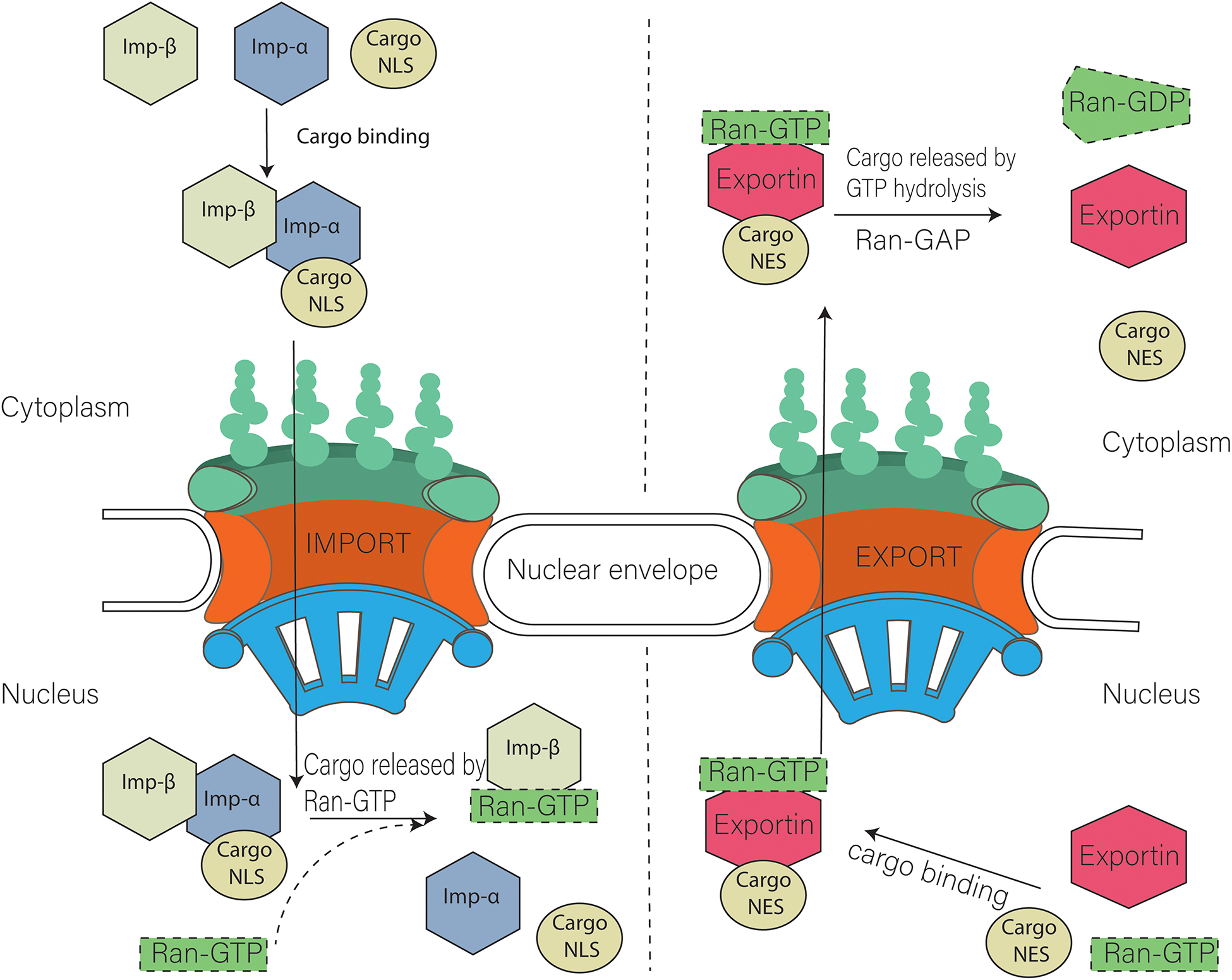
Figure \(\PageIndex{21}\): Model of nuclear import and export. Cargo containing NLS (Nuclear localization betoken) is imported with the help of Importin α and importin β heterodimer. Nuclear export of cargo having NES (nuclear export signal) is carried out with the help of exportins. Ran GTP is too required during that process.Khan Asmat Ullah, Qu Rongmei, Ouyang Jun, Dai Jingxing. Front. Physiol., 03 April 2022 | https://doi.org/10.3389/fphys.2020.00239.Artistic Commons Attribution License (CC BY).
Figure \(\PageIndex{22}\) below shows an interactive iCn3D model of the Delpi electrostatic surface potential map of the putative NLS from the carboxy-last of a cargo protein, the Westward poly peptide of the Hendra virus which is imported into the nucleus.
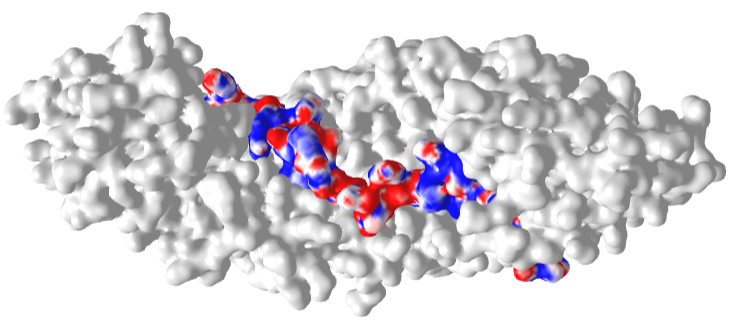
Figure \(\PageIndex{22}\): Delpi electrostatic surface potential map of the putative NLS from the carboxy-final of a cargo protein, the Westward poly peptide of the Hendra virus which is imported into the nucleus (Copyright; author via source). Click the prototype for a popup or use this external link: https://construction.ncbi.nlm.nih.gov/i...mUkDXG1KoiieTA
The virus derives from bats and has recently emerged. The peptide sequence containing the NLS has the following sequence: 419 CLGRRVVQPGMFADYPPTKKARVLLR 444. The red surface indicates negative potential and blue positive potential, which is associated with the Lys and Arg side bondage in the consensus sequence. It is shown bound to the human importin-α3 subunit (molecular surface shown in white), which binds the NLS sequence with loftier affinity.
An acute reader might ask why GTP stays spring and is not cleaved into Gross domestic product in the nucleus by the intrinsic GTPase action of Ran. It turns out there is yet another protein establish merely in the cytoplasm (i.e. it doesn't have a nuclear import signal), which binds to Ran:GTP and promotes GTP → GDP exchange. So in an odd way, hydrolysis of a nucleoside triphosphate (GTP, non ATP as in the case of most transporters discussed above) is required for nuclear import. A different but very fascinating mechanism!
The cargo complexes described higher up must still pass through the nuclear pore. In section 11.3 we discussed the structure of the nuclear pore which consist of many nucleoporin proteins (NUPs). The inner ring is called the FG Nups layer. The disordered parts of the inner ring Nups accept repetitive sequences enriched in phenylalanine and glycine (hence the name FG Nups) and stick out into the central pore. The FG repeats can take multiple forms include Phe-Gly (FG), Gly-Leu-Phe-Gly (GLFG), or Phe-whatsoever-Phe-Gly (FXFG). These are intrinsically disordered proteins and the disordered regions in the pore act as a filter allowing certain molecules to laissez passer and excluding those greater with molecular weights greater than 40K. Large molecules complexed to importins/exportins move through the pore. This disordered mesh prevents passive diffusion of molecules through information technology, but allows protein complexes with cargo:exportin/importin circuitous through. It'due south a flake like electrophoresis of small-scale poly peptide complexes through the pores of an acrylamide or agarose gel polymerized matrix, just without the "push" of an electrical field. Presumably, the FG-Nups make transient induced-dipole:induced dipoleinteractions between the FGs on the Nups and the nuclear transport receptors.
Figure \(\PageIndex{23}\) below show anexport complex (5XOJ) from yeast of Ran (cyan with spring GTP in spacefill) bound to an exportin (Xpo1p, white surface) and iii Nup42p peptides containing SxFG/PxFG repeats (spacefill, side chains, which are by and large nonpolar). To bind three Nup peptides, the exportin Xpo1 too contains repeating binding sites on domains called HEAT repeats fourteen–20 of Xpo1p, The exportin Xpo1p is shaped similar a toroid with 21 HEAT repeat domains that accept two antiparallel with connecting loops of dissimilar sizes.
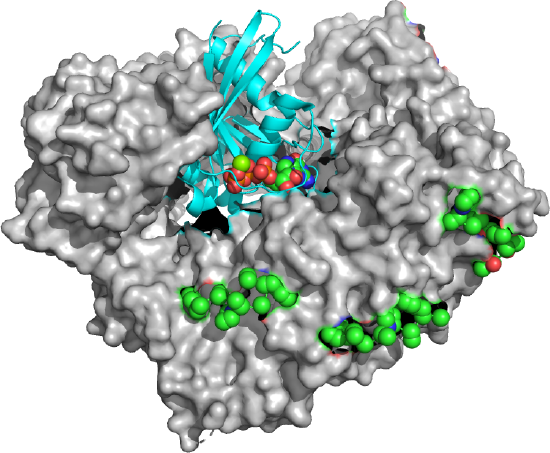
Effigy \(\PageIndex{23}\): Yeast export complex (5XOJ) with Ran (cyan with bound GTP in spacefill) jump to an exportin (Xpo1p, grayness surface) and three Nup42p peptides containing SxFG/PxFG repeats (spacefill, side bondage))
Some believe the unfolded mesh of FGs in the core might condense on binding of motiffs on importins/exportins or through FG:FG domain associations. But what is the basis for importins/exportins interactions with the FG structures? To study information technology in more item Fragasso et al designed and made an artificial FG-Nup that binds to an importin transport receptor Kap95that interacts with a cargo protein with a nuclear localization sequence (NLS) in cargo proteins. The attached them to the inside of solid-state nanopores and demonstrated fast movement of Kap95 through the derivatized nanopore while a command "noncargo" without a NLS, BSA) was blocked. Underivatized nanometer-sized pores are fabricated in a silicon nitride synthetic membrane (SiN) by using an ion or electron beam to melody the size of the hole.
Figure \(\PageIndex{24}\) below (top image) shows colored lawmaking structures of the inner band (top of figure) snapshots of different yeast GLFG nups. These are named after their Gly-Leu-Phe-Gly repeating motifs and are peculiarly cohesive. The GLFG-Nups, shown in red, are by and large found in the inner band compared to FxFG/FG-Nups shown in greenish.
Figure \(\PageIndex{24}\): Inner ring (acme of figure) snapshots of unlike yeast GLFG nups.Fragasso, A., de Vries, H.Due west., Andersson, J.et al. A designer FG-Nup that reconstitutes the selective ship barrier of the nuclear pore complex.Nat Commun12,2010 (2021). https://doi.org/x.1038/s41467-021-22293-y. Creative Eatables Attribution 4.0 International License. http://creativecommons.org/licenses/past/4.0/.
The bottom part of Figure \(\PageIndex{24}\) above show snapshots of molecular dynamics simulations of various yeast GLFG-Nups compared to the NupX synthetic one. Iii of the yeast GLFG Nups and the synthetic NupX show a meaty and extended domain Each has a collapsed cohesive domain at i end (characterized by a low accuse to hydrophobic amino acrid residue ratio (C/H ), lots of alternate FG and GLFG repeats, with light green showing non-FG/GLFG/charged residues ) and an extended domain at the other finish (high ratio of charged/hydrophobic amino acids, no FG repeats, pink-red showing non-FG/GLFG/charged residues). Vivid green shows the FG repeats, red the GLFG repeats, and white the charged groups.
Figure \(\PageIndex{25}\) beneath shows the pore in the silicon nitride synthetic membrane (SiN) membrane before (left) and afterwards derivitization with NupX.
Figure \(\PageIndex{25}\): Pore in the SiN silicon nitride constructed membrane before (left) and after derivitization with NupX
Figure \(\PageIndex{26}\) below shows derivatized pores in the SiN membrane of increasing size. In the smallest pre, the NupXs don't fit and are expelled grade the pore. In the 30 nm pre, the NupX cohesive domains plug the hole. In the 45 nm pore, a hole appears.
Figure \(\PageIndex{26}\): Derivatized pores in the silican nitride (SiN) membrane of increasing size
Lastly, Effigy \(\PageIndex{27}\) below shows snapshots of 30 nm pores lines with NupXs. In panel c, an importin, Kap95 (spheres with orange bounden spots) is shown forming transient interaction with and translocating through the NupX-lined hole. BSA (sphere without bounden sites) may interact weakly but does not translocate through the pore.
Figure \(\PageIndex{27}\): Snapshots of 30 nm pores lines with NupXs. and interacting with an importin, Kap95 (spheres with orange bounden spots, panel C) and BSA (sphere, panel D)

0 Response to "Active Transport Can Only Be Driven by the Hydrolysis of High-energy Phosphate Bonds."
Enregistrer un commentaire